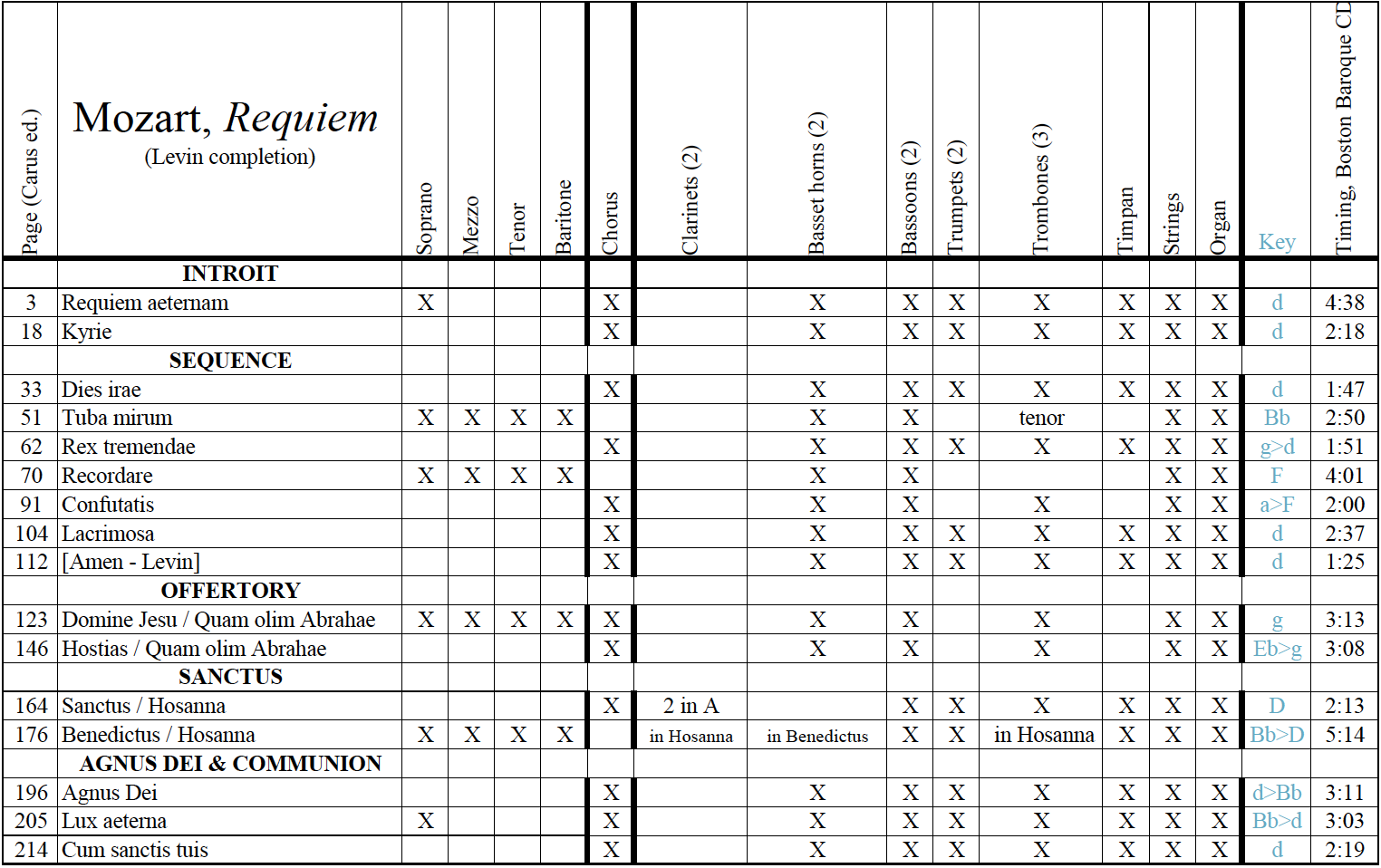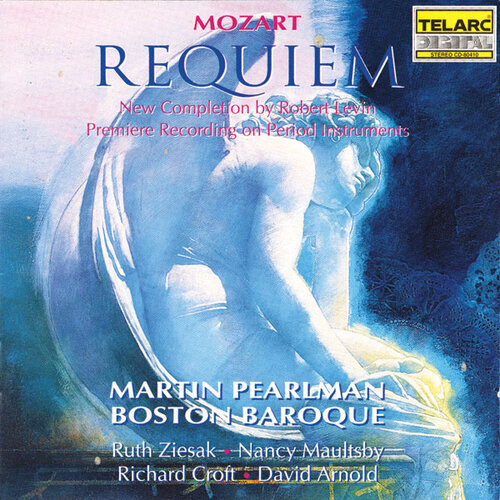Requiem in D minor, K. 626
Soloists: Soprano, alto, tenor, bass
Chorus: SATB
Orchestra: 2 basset horns/2 clarinets, 2 bassoons,
2 trumpets, 3 trombones, timpani, organ
[Clarinets in Robert Levin completion only for Sanctus and Hosanna.
The traditional Süssmayr version has only basset horns.]
Introit:
Requiem
Kyrie
Sequence:
Dies irae
Tuba mirum
Rex tremendae
Recordare
Confutatis
Lacrimosa
Amen [in Levin completion]
Offertory:
Domine Jesu
Hostias
Sanctus:
Sanctus-Hosanna
Benedictus-Hosanna
Agnus Dei:
Agnus Dei
[Communion]:
Lux aeterna
Cum sanctis tuis
Program Notes by Martin Pearlman
In mid-1791, when he was working on The Magic Flute, Mozart was visited by a stranger who commissioned him to write a requiem. Mozart was offered a significant fee, half of it in advance, on the condition that it be anonymous. The secret patron behind the commission was Count Franz von Walsegg, who intended to pass off the work as his own composition in memory of his recently departed young wife.
Toward the end of that year, after completing The Magic Flute and fulfilling a late commission for another opera, La Clemenza di Tito, Mozart was able to become fully engaged in writing his requiem. By that time, however, he was seriously ill and needed to dictate some of his composition to an assistant. His friend Benedikt Schack, the tenor who sang Tamino in The Magic Flute, relates that, on the afternoon before Mozart died, the composer had the unfinished manuscript of the Requiem brought to him in bed and sang through the vocal parts with several friends. Schack tells us that Mozart himself sang the alto part but got only as far as the Lacrimosa, at which point he broke into tears and put the score aside. He died during that night of December 5, age 35.
Completing the Requiem
In the manuscript that Mozart left at his death, only the opening section, the Introit, was more or less complete. Beyond that, nine more sections were sketched; that is, the vocal solo and choral parts plus the orchestral bass line were filled in for the Kyrie through the Hostias, although the famously beautiful Lacrimosa broke off completely after only eight bars. In these movements, there are just occasional hints at figuration for the orchestra. Missing entirely were the final movements: Sanctus, Benedictus, Agnus Dei, Lux aeterna, and Cum Sanctis tuis.
In need of the sizable fee for the commission, Mozart's widow Constanze decided to have the score secretly completed and presented as her husband's work. She first turned to Joseph Eybler, a composer and former student who had been well respected by Mozart. Eybler orchestrated some parts of the work but then declined to complete the task for reasons that we can only speculate about. Did he perhaps find it too daunting to work in Mozart's shadow, especially with some movements not even begun? After a couple of other musicians declined the task, Franz Xaver Süssmayr agreed to take it on. Süssmayr had been a family friend and a student of Mozart's, but he was considerably less skilled as a composer than Eybler.
In order to complete the Requiem, he had to fill out the orchestration, extend the fragmentary Lacrimosa into a complete movement, and compose the missing Sanctus and Benedictus from scratch. For the closing Agnus Dei and Communion, he decided to adapt Mozart's own music from the beginning of the work, setting it to the appropriate text for the end of a requiem.
Although Süssmayr's version has long been considered the standard completion of the work and is thus the one most frequently performed, it has been controversial for over 200 years. His effort has frequently been criticized as being weak and un-Mozartean in many passages, for containing basic errors of musical grammar, and for being too thickly orchestrated for a Mozart work, with its extensive instrumental doubling of voice parts.
Nonetheless, it is the one version that comes not only from the eighteenth century but from Mozart's inner circle. It may, for all we know, incorporate some verbal instructions from the composer himself or original sketches that are now lost to us. Indeed, the sections that Süssmayr claimed to be his own (Sanctus and Benedictus) have often been considered too good to be his, considering the quality of his own original music, and are thus suspected of incorporating some of Mozart's instructions. Constanze recalled giving him a "few scraps of music," along with the unfinished manuscript, and her sister, Sophie Haibel, claimed that, on the night before he died, Mozart had given Süssmayr directions as to how he wanted the work completed. But these were memories from several decades later, and it is impossible to know how accurate they were or even whether there may have been a wish to make the work more fully Mozart's. Nonetheless, they are additional reasons not to dismiss Süssmayr's work entirely, despite its problems.
The Levin version
In 1995, Boston Baroque recorded for Telarc the period-instrument premiere of Robert Levin's soon-to-be-published version of the Requiem. Several other new versions had come out in the previous decades, but what was particularly attractive about this one was not only its scholarly grounding but also its respect for the history of the work and its effort to repair and improve the familiar Süssmayr version, rather than to replace it.
The repairs range from many small details to significant changes in the orchestration, as well as occasional new twists in the harmony that have surprised those who know the traditional version of the Requiem. The orchestration, which is new in many places, is more transparent than Süssmayr's, errors in voice leading have been corrected, and awkward harmonic progressions have been made more Mozartean. The Hosanna fugue at the end of the Sanctus has been extended beyond Süssmayr's rather timid effort, giving it proportions more typical of Mozart.
Perhaps the most striking new material in this version is the Amen fugue at the end of the Lacrimosa. With Mozart's manuscript breaking off before the end of that movement, Süssmayr brings it to a simple close with the word "Amen." However in 1963, a sketch in Mozart's hand was discovered with counterpoint for the opening bars of a fugue, material that appeared to have been meant for an Amen at the end of the movement. Levin has worked the fragment into a completed fugue which, unlike some earlier efforts, remains in a single key throughout, as did Mozart's fugues for similar endings. Perhaps Mozart himself may have done something along these lines, or he may instead have mixed the material with more modern, homophonic music, as he sometimes did in other works -- or he might simply have discarded the sketch and ended the Lacrimosa without a fugue. Did Süssmayr mistakenly overlook the sketch, or, as Christoph Wolff has wondered, did he lack the confidence to write a full fugue in a Mozart work? Did Mozart himself decide to discard it? We will probably never know, but Robert Levin has given us a possible way of listening to this movement as an extended piece. At the same time, we feel a tragic sense of loss as the fragment of the Lacrimosa dies illa (On that day of tears) passes from the eighth to the ninth bar, where Mozart's manuscript abruptly breaks off and that of the completion takes over.
Orchestration Chart
This chart gives an overview of the work, showing which soloists and instruments are in each movement. It has also been useful in planning rehearsals, since one can see at a glance all the music that a particular musician plays. Red X's indicate major solo moments for a singer. An X in parentheses indicates that the use of that instrument is ad libitum.
This is a preview of the beginning of the chart. You can download or view a PDF of the whole chart here.
© Boston Baroque 2020
Boston Baroque Performances
Requiem in D minor, K. 626 (Levin completion)
October 20 & 22, 2017
NEC’s Jordan Hall, Boston, MA
Martin Pearlman, conductor
Soloists:
Amanda Forsythe, soprano
Ann McMahon Quintero, mezzo-soprano
Thomas Cooley, tenor
Kevin Deas, bass-baritone
March 1 & 3, 2001
NEC’s Jordan Hall, Boston, MA
Martin Pearlman, conductor
Soloists:
Sharon Baker, soprano
Deanne Meek, mezzo-soprano
John Aler, tenor
Kevin Deas, bass-baritone
May 7, 1994
NEC’s Jordan Hall, Boston, MA
Martin Pearlman, conductor
Soloists:
Dominique Labelle, soprano
Pamela Dellal, mezzo-soprano
Steven Tharp, tenor
David Arnold, baritone


